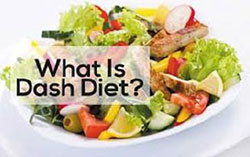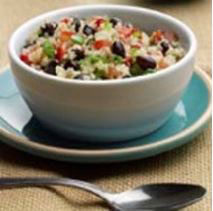DASH Diet: Health for the Whole Family
By: Glenda Wentworth, Family & Consumer Science Extension Agent, Eagle County

The DASH eating plan is a healthy way of eating that can benefit everyone in the family. DASH stands for Dietary Approaches to Stop Hypertension. The DASH eating plan can help with prevention and management of high blood pressure. It has also been shown to be helpful in prevention and management of certain cancers, diabetes, heart disease, stroke, and osteoporosis. The DASH eating plan was designed by a panel of nutrition and health experts. It is based on research studies sponsored by the National Heart, Lung, and Blood Institute.
The DASH eating plan is a pattern anyone of any age can follow for a healthy lifestyle. The DASH eating plan emphasizes fat-free or low-fat milk and calcium products, vegetables, fruits, whole grains, fish, poultry, beans, seeds and nuts. The great thing about DASH is that it does not require any special foods and can include easy-to-follow recipes. The basic DASH eating guidelines limits sodium to 1,500 to 2,300 mg per day to play a role in lowering blood pressure.
Tips:
- To get started on the DASH eating plan, make a few simple changes one at a time. Slowly increaseyour servings of vegetables, fruits, lean proteins, and whole grains over several weeks. This will giveyou and your family a chance to adjust to the changes and make them part of your daily routine.
- Choose 100% whole-grain foods for most of your grain servings. This adds nutrients, such asminerals and fiber. For example, choose 100% whole-wheat bread or whole-grain cereals.
- Include 3 servings of fat-free or low-fat dairy products a day. If you have trouble digesting dairyproducts, try lactose-free or lactose-reduced milk at the grocery store.
- Limit lean meats to 6 ounces a day. Have only 3 ounces of lean meat (about the size of a deck ofcards) at a meal. If you usually eat large portions of meat, cut back over a couple of days—by half or athird at each meal.
- Include 2 or more vegetarian-style, or meatless, meals each week.
- Read the Nutrition Facts label on foods to compare the amount of sodium (salt) in products. Lookfor the sodium content in milligrams (mg) and the Percent Daily Value. Aim for foods that haveless than 5% of the daily value of sodium. Foods with 20% or more of the daily value of sodium areconsidered high-sodium foods.
- Reduce as many sweets, added sugars, and sugar-containing beverages aspossible.
- If you don’t like nuts or are allergic to them, use seeds or legumes (cooked driedbeans or peas) as part of your eating plan.

- If you take medicines to control your high blood pressure, keep taking them.However, you should tell your doctor that you’re now following the DASHeating plan.
- For more information: In Brief: Your Guide to Lowering Your Blood Pressurewith DASH at: http://www.nhlbi.nih.gov/files/docs/public/heart/new_dash.pdf
| Food Group | Daily Servings | Examples of 1 serving |
| Whole Grains and grain products | 7 – 8 | 1 slice whole-wheat bread ½ cup cooked cereal ½ cup cooked rice or pasta |
| Vegetables | 4 – 5 | 1 cup raw leafy green vegetable ½ cup cut-up or cooked vegetables |
| Fruit | 4 – 5 | 1 medium fruit ½ cup fresh, frozen, or canned fruit ¼ cup dried fruit |
| Low-fat or fat free milk or calcium products | 2 – 3 | 1 cup (8 fluid oz.) milk 1 cup yogurt 1 ½ oz. Cheese |
| Lean meats, poultry and fish | 2 or less | 1 oz. cooked lean meat, skinless poultry or fish 1 egg 2 egg whites |
| Nuts, seeds and beans | 4 – 5 a week | 1/3 cup nuts 2 tablespoons peanut butter 2 tablespoons seeds ½ cup cooked legumes (fried beans or peas) |
| Fats, oils, and sweets | limited | 1 teaspoon soft margarine 1 teaspoon vegetable oil 1 tablespoon mayonnaise 2 tablespoons salad dressing |
Let’s Talk
Including children in the discussion and letting them help make plans and decisions increases the chance they will accept changes.
- Discuss with your children how to add a serving of vegetables at lunch and another at dinner. Add one more serving of fruit at one meal or as a snack.
- Ask children to help you pick out and taste test a variety of whole grain foods to serve as snacks and at meals. Include a variety of pastas, breads, crackers, cereals, tortilla, etc.
- Some children don’t like the taste or mouth feel of fluid milk. If this is the case, ask them to help you brain storm and try other low-fat dairy foods and nondairy foods high in calcium. Examples include fortified orange juice, fortified tofu (calcium sulfate), soy beans, white or red beans, eggs, fish canned with bones, collard greens, spinach, bok choy, sesame seeds and sesame butter.
Recipe for Health:
Quinoa and Black Bean Salad

Ingredients:
- 1½ cup dry quinoa
- 1½ cups water
- 1½ tablespoons olive oil
- 3 tablespoons lime juice
- ¼ teaspoon cumin
- ¼ teaspoon ground coriander (dried cilantro seeds)
- 2 tablespoons cilantro, chopped
- 2 medium scallions, minced
- 1 can (15 ounces) black beans, rinsed and drained, (preferably low sodium)
- 2 cups tomato, chopped
- 1 medium red bell pepper, chopped
- 1 medium green bell pepper, chopped
- 2 fresh green chilies (or to taste), minced
- black pepper (to taste)
Directions:
- Rinse the quinoa in cold water. Boil water in a saucepan, and then add the quinoa. Return to boil, then simmer until the water is absorbed, 10 to 15 minutes. Cool for 15 minutes.
- While quinoa is cooking, mix olive oil, lime juice, cumin, coriander, chopped cilantro, and scallions in a small bowl, and set aside.
- Combine chopped vegetables with the blackbeans in a large bowl, and set aside.
- Once quinoa has cooled, combine all ingredients and mix well. Cover and refrigerate until ready to serve.
Serving Size: 1 cup, 6 servings per recipe





